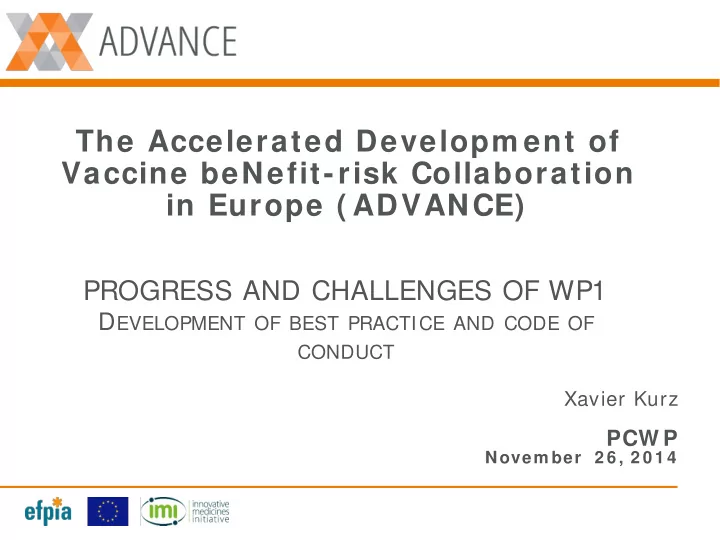

The Accelerated Developm ent of Vaccine beNefit-risk Collaboration in Europe ( ADVANCE) PROGRESS AND CHALLENGES OF WP1 D EVELOPMENT OF BEST PRACTICE AND CODE OF CONDUCT Xavier Kurz PCW P Novem ber 2 6 , 2 0 1 4
Rem inder: W hy a project on B/ R m onitoring? Experience gained w ith routine vaccines and H1 N1 pandem ic • EU capacity for collecting vaccine exposure, safety and effectiveness data is limited: • Difficulty to initiate and conduct studies • Interactions between multiple stakeholders (regulators, public health agencies, academia, industry) – lack of confidence • Disharmonised communications • Funding issues – contractual issues -perceived conflicts of interest • Multinational collaborations are possible • Lessons learnt from European consortia in vaccine effectiveness (I- MOVE) and safety (VAESCO) 2
Rem inder: Objective of ADVANCE To build a B/ R vaccine monitoring system: • Efficient and sustainable • Rapid and integrated • Clear governance rules • Meeting the common interest of all main stakeholders 3
WP7 Blueprint for benefit-risk monitoring WP5 Proof of concept ADVANCE PROJECT WORKPLAN Project Management & studies WP6 Methods Communication WP4 Best Data WP1 WP3 practice sources Creation of Synergies WP2 4
O BJECTI VE OF W P1 To develop and test a best practice guidance for the initiation, conduct and reporting of studies on the benefits and risks of vaccines in Europe. 5
The best practice guidance should: • include governance principles , code of conduct , m inim um quality requirem ents and com m unication principles • be practical (eg. funding aspects, interaction between involved stakeholders) • be agreed by all stakeholders (i.e. large consultation needed) • be sustainable (eg. funding mechanisms, training) • be tested in real-life situations • take into account different situations and different needs and requirem ents of involved stakeholders for a given study. 6
TNERS INVOLVED PAR ARTN • Regulatory authorities : • EMA, MHRA, AIFA, ANMS • Public health agencies: • ASLCR, WIV-ISP , SSI, RIVM, NCE, FISABIO, THL • Academia: • EMC, UNIBAS, Surrey, OU, LSHTM, KI, AUH-AS, UTA, RCGP , ICL • SME/ CRO: • P95, Synapse, Pedianet • Industry: • GSK, SP , Novartis, SP MSD, Crucell, Pfizer, Takeda 7
Four w orking groups • Code of conduct • Quality control and assurance • Governance models • Communication strategy W P1 W orkshops • 1 3 Novem ber 2 0 1 3 • 1 3 -1 4 Novem ber 2 0 1 4 Representatives from PCWP (2014: Jose Drabwell, Marco Greco) 8
Code of conduct Objective To identify/ develop components of a code of conduct Key element is consensus among all stakeholders Starting from review of existing guidance (22) and literature review Access to data Roles and responsibilities Confidentiality Scientific Independence Conflicts of interest Study conduct Development of study protocol Transparency Ownership of results Writing of study report Publications and communications Research contracts 9
Code of conduct Tim eline: first draft in March 2 0 1 4 Challenges • definitions of terms and concepts • balance between requirements and need for consensus • impact on research contracts and legal aspects • formalisation of agreement 10
Quality control and assurance Objective To propose minimum requirements for quality standards to provide confidence in the validity of results and support a mutual understanding of quality control and assurance. Challenges • Most organisations already have procedures in place and use guidance • Large variability of documents being used as reference • National accreditations exist • Need to ensure and communicate that the same minimum criteria are applied. 11
Governance models Objective To perform a landscape analysis of existing models of multi- stakeholder initiatives for the framework (including public-public, private-private and public-private interactions (PP)) and describe operational models with different scenarios for PP interactions. Challenges • Definition of generic functions and activities • Differentiation between funding mechanisms and governance model 12
Communication strategy Objective To provide recommendations on effective communication strategies for disseminating study results and evaluations on the benefits and risks of vaccines for supporting stakeholders in making informed decisions. Includes: • planned proactive communication as well preparedness for communicating on emerging needs; • addressing concerns and information needs of the public (including vaccinees(-to-be), carers, healthcare professionals, vaccination policy makers) • mitigating media crises . 13
Milestones √ Finalisation of Survey on w hite paper Topics PP interaction Sept 2017 PoC Ph I I Apr 2014 √ Jan 2016 √ 3 rd 1 st Topics 2 nd W orkshop W orkshop PoC Ph I W orkshop Oct 2016 13 Nov 2013 Oct 2014 Dec 2015 End of Start project date: 3 0 Sept Oct 2 0 1 8 2 0 1 3 Draft list of study Analysis of Draft Final best practice needs public best practice guidance √ and framework concerns and guidance Oct 2016 requirements perceptions Apr 2015 Final model Apr 2014 Oct 2014 PP interactions Analysis of Oct 2016 key issues Results of Initial model √ Strategy for public and gaps in survey-PP PP interactions communication public interactions Jan 2015 Oct 2016 14 knowledge Jul 2014 Deliverables Oct 2015
Other update: Proof-of-concept studies Three topics selected for first wave: • HPV vaccines • Influenza vaccines • Pertussis vaccines First study: Pertussis • To estimate burden of pertussis disease and identification of outbreaks over time. • To estimate pertussis vaccination coverage and schedule compliance in various populations and countries, and various combinations. • To estimate pertussis vaccine effectiveness • To assess the risk for established safety outcomes 15
Thank you ! 16
Recommend
More recommend